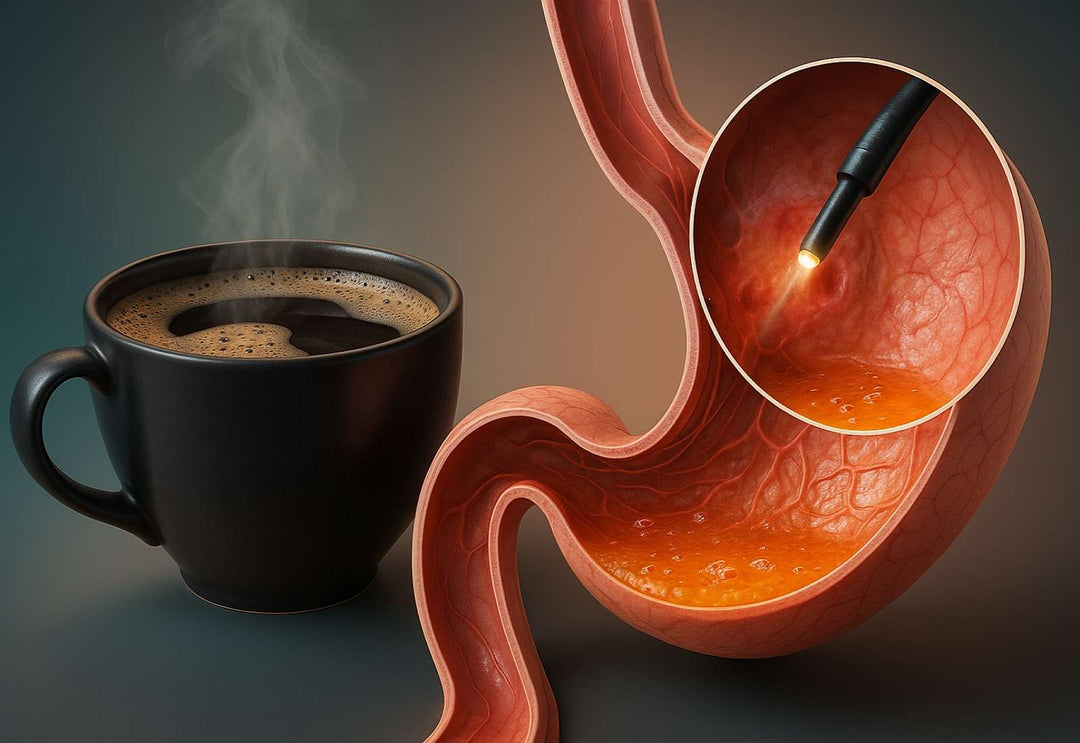Caffeine Content in Coffee
Introduction

Are you the type of person who can't start the day without a cup of joe? If so, you're not alone. Coffee has become a daily ritual for millions around the world, but have you ever wondered just how much caffeine you're consuming with each sip?
In this article, we delve into the fascinating world of caffeine content, taking you on a journey from bean to brew. Whether you're a coffee connoisseur or simply enjoy the occasional cup, understanding the caffeine levels in your favorite brew can help you make more informed choices about your caffeine intake.
We'll explore the different factors that contribute to the caffeine content in coffee, including the type of bean, the brewing method, and even the serving size. Additionally, we'll touch on the impact of caffeine on your body and how to manage your caffeine consumption for optimal energy levels throughout the day.
Join us as we uncover the secrets of caffeine and discover just how much of a buzz your beloved beverage provides.What is the Caffeine Content in Coffee?
The caffeine content in coffee can vary depending on several factors, including the type of coffee bean, the brewing method, and the serving size. On average, an 8-ounce cup of brewed coffee contains about 95 milligrams of caffeine. However, this can range from as low as 30 milligrams to as high as 200 milligrams, depending on the variables mentioned earlier.
It's important to note that caffeine content can also vary between different coffee brands and even within the same brand, so it's always a good idea to check the packaging or consult the barista if you're unsure about the caffeine content of your coffee.
*At General Warfield's Coffee our coffees range from 90-100mg of caffeine per 8oz cup.
What Factors Affect Caffeine Levels in Coffee?

The caffeine content in coffee is primarily influenced by the type of coffee bean used. There are two main species of coffee beans: Arabica (Coffea arabica) and Robusta (Coffea canephora). Arabica beans are generally considered to have a smoother and more nuanced flavor, while Robusta beans are known for their stronger and more bitter taste.
In terms of caffeine content, Robusta beans contain about twice as much caffeine as Arabica beans. This is due to the genetic differences between the two species. Robusta plants naturally produce more caffeine as a defense mechanism against insects and other pests.
Aside from the type of bean, the way the coffee beans are roasted can also impact the caffeine content. Contrary to popular belief, lighter roasts actually contain slightly more caffeine than darker roasts (though the differences are very slight). This is because the longer roasting process of darker beans can cause some of the caffeine to break down.
The brewing method is another crucial factor that determines the caffeine levels in your cup of coffee. Methods like espresso and French press tend to extract more caffeine from the beans compared to drip brewing. The finer grind size and longer extraction time of these methods allow for higher caffeine concentration.
Caffeine Concentration by Coffee Species:
As discussed above caffeine content in coffee beans is primarily influenced by the species of the coffee plant. Each species contain different levels of caffeine as shown bleow:
1. Arabica (Coffea arabica):
This is the more common type, making up about 70% of global coffee production. It is generally considered higher quality with a smooth taste and clean cup. It generally contains around 1.2% to 1.5% of caffeine by weight. For example: if you had 100 grams of Arabica coffee beans, they would contain between 1.2 to 1.5 grams of caffeine.
2. Robusta (Coffea canephora):
This species is hardier and can be grown in lower altitudes and warmer temperatures compared to Arabica. It's often considered to be of lower quality in terms of flavor, as it can be more bitter and less acidic. Robusta beans generally contain more caffeine, usually between 2.2% to 2.7% by weight. In this example, if we had 100 grams of Robusta coffee beans, they would contain about 2.2 to 2.7 grams of caffeine.
Arabica vs Robusta Global Production & Relative Caffeine Content:
Coffee ChartKey to Chart Above:
- Arabica (in green): This type accounts for about 70% of global coffee production (1.2% to 1.5% caffeine by weight).
- Robusta (in red): This type represents the remaining 30% of global coffee production (2.2% to 2.7% by weight).
Caffeine Content in Different Forms of Coffee

Coffee comes in various forms, from a simple black brew to fancy espresso-based beverages. The caffeine content can differ significantly depending on the type of coffee drink you choose.
A standard 8-ounce cup of brewed coffee typically contains around 95 milligrams of caffeine, as mentioned earlier. However, other popular coffee drinks can have higher or lower caffeine content.
Espresso, for example, is a concentrated form of coffee that is commonly used as the base for many specialty drinks. A single shot of espresso (about 1 ounce) contains approximately 63 milligrams of caffeine. However, it's important to note that espresso-based beverages like lattes or cappuccinos often contain multiple shots of espresso, which can increase the overall caffeine content.
On the other end of the spectrum, decaffeinated coffee is a popular choice for those who want to enjoy the taste of coffee without the stimulant effects of caffeine. Decaf coffee still contains a small amount of caffeine, usually around 2 to 5 milligrams per 8-ounce cup. The decaffeination process removes most of the caffeine, but it's not entirely eliminated.
| Type of Coffee | Caffeine Content | Measurement |
|---|---|---|
| Brewed Coffee | 95mg | per 8oz |
| Espresso | 63mg | per 1oz |
| Decaf | 2-5mg | per 8oz |
Comparing Caffeine Content in Tea, Soda, and Energy Drinks
While coffee is often associated with caffeine, it's not the only beverage that can provide a pick-me-up. Tea, soda, and energy drinks also contain varying amounts of caffeine.
Tea, particularly black tea, is known for its caffeine content. A typical 8-ounce cup of black tea contains around 47 milligrams of caffeine, which is significantly less than a cup of coffee. Green tea, on the other hand, contains about 28 milligrams of caffeine per cup. Herbal teas, such as chamomile or peppermint, are naturally caffeine-free.
Soda drinks can also contain caffeine, although the amount can vary depending on the brand and flavor. A 12-ounce can of cola typically contains around 30 to 40 milligrams of caffeine. However, it's worth noting that many soda companies also offer caffeine-free options.
Energy drinks are notorious for their high caffeine content, designed to provide an instant energy boost. The caffeine content in energy drinks can range from 70 to 240 milligrams per 8-ounce serving. However, it's important to consume energy drinks in moderation due to their high sugar and caffeine content, as excessive consumption can have adverse health effects.Table 2. Comparison of Various Caffeinated Beverages:
| Drink Type | Average Caffeine Content |
|---|---|
| Black Tea | 40-70mg (per 8oz) |
| Green Tea | 20-45mg (per 8oz) |
| Cola (Soda) | 34mg (per 12oz) |
| Energy Drink (Brand A) | 80mg (per 8oz) |
| Energy Drink (Brand B) | 150mg (per 8oz) |
How to Measure Caffeine Content in Your Own Home
If you prefer brewing your own coffee at home, you might be wondering how to measure the caffeine content accurately. While it's challenging to determine the exact caffeine content without specialized equipment, there are a few methods you can use to estimate the caffeine levels in your homemade brew.
One way is to check the packaging of your coffee beans. Many coffee brands provide information about the caffeine content on their packaging, allowing you to make an informed decision. However, keep in mind that these figures are often averages and can still vary depending on brewing variables.
Another option is to use online caffeine calculators or mobile apps designed to estimate caffeine content based on brewing parameters. These tools consider factors such as bean type, brewing method, and serving size to give you an approximate caffeine value.
If you're particularly interested in the caffeine content of your homemade coffee, you can invest in a home coffee testing kit. These kits use chemical tests to measure the caffeine levels in your brewed coffee accurately. While they may not be as precise as professional lab tests, they can provide a good indication of the caffeine content.What Are the Health Effects of Consuming Too Much Caffeine?
One of the most common side effects of too much caffeine is sleep disruption. Caffeine stimulates the central nervous system, making it harder to fall asleep or stay asleep. This can lead to sleep deprivation, which can have a negative impact on your overall health and well-being.
High caffeine intake can also cause symptoms such as restlessness, increased heart rate, and anxiety. Some individuals may be more sensitive to the effects of caffeine than others, so it's important to listen to your body and adjust your caffeine consumption accordingly.
Additionally, excessive caffeine consumption can lead to caffeine dependence or addiction. Regularly consuming large amounts of caffeine can lead to tolerance, meaning you may need more caffeine to achieve the same effects over time. Withdrawal symptoms, such as headaches and irritability, can occur when you suddenly decrease or stop your caffeine intake.
Individuals with certain health conditions, such as heart problems or anxiety disorders, may be more susceptible to the negative effects of caffeine. It's always a good idea to consult with a healthcare professional if you have any concerns about your caffeine consumption.
While moderate caffeine consumption is generally safe for most people, consuming excessive amounts of caffeine can have adverse health effects. It's essential to understand the potential risks associated with high caffeine intake and to manage your consumption accordingly.
Caffeine Alternatives for those Looking to Reduce their Intake

If you're looking to reduce your caffeine intake but still want a flavorful and energizing beverage, there are plenty of caffeine-free alternatives to consider.
Herbal teas are a popular choice for those seeking a warm and soothing drink without the caffeine. Chamomile, peppermint, and rooibos teas are caffeine-free options that offer a variety of flavors and potential health benefits.
Another caffeine-free alternative is decaf coffee, which undergoes a process to remove most of the caffeine. Decaf coffee can still provide the taste and aroma of regular coffee without the stimulating effects of caffeine. Just be sure to check the packaging or ask your barista for the decaffeinated options.
For a refreshing and hydrating option, consider flavored water or fruit-infused water. These beverages can provide a burst of flavor without any caffeine or added sugars. You can experiment with different fruits and herbs to create your own unique combinations.
Lastly, don't forget about the power of good old-fashioned water. Staying hydrated is essential for overall health and can help keep you energized throughout the day. If you find yourself reaching for a caffeinated beverage out of habit, try swapping it for a glass of water and see how you feel.Tips for Managing Caffeine Consumption
If you want to enjoy the benefits of caffeine while still maintaining a balanced intake, here are some tips for managing your caffeine consumption:
1. Keep track of your caffeine intake:
Take note of how much caffeine you consume in a day and be mindful of your overall consumption. This can help you identify any patterns or habits that may need adjusting.
2. Gradually reduce caffeine intake:
If you're looking to cut back on caffeine, try reducing your intake gradually rather than quitting cold turkey. This can help minimize withdrawal symptoms and make the transition easier.
3. Experiment with caffeine-free alternatives:
Explore different caffeine-free beverages to find ones that you enjoy. This can help satisfy your taste buds and provide variety in your beverage choices.
4. Be aware of hidden sources of caffeine:
Caffeine can be found in unexpected places, such as certain medications, chocolate, and even some skincare products. Read labels carefully and be mindful of these hidden sources.
5. Pay attention to your body's signals:
Everyone reacts differently to caffeine, so it's important to listen to your body. If you notice any negative effects or discomfort after consuming caffeine, consider adjusting your intake accordingly.
6. Practice good sleep hygiene:
To ensure you get quality rest, avoid consuming caffeine close to bedtime. The stimulating effects can interfere with your sleep, leading to restless nights and daytime fatigue.
Conclusion: Understanding and Enjoying Caffeine Responsibly
Coffee has become an integral part of many people's daily routines. From its rich aroma to the health benefits, and energizing effects, coffee offers a unique experience that brings joy to millions around the world.
By understanding the caffeine content in coffee and other beverages, you can make more informed choices about your caffeine intake. Factors such as the type of bean, brewing method, and serving size all play a role in determining the caffeine levels in your cup.
While caffeine can provide a much-needed boost, it's important to consume it responsibly and be mindful of your overall intake. Too much caffeine in some individuals can lead to health issues like jitteriness, increased heart rate, and digestive problems. Additionally, it can also disrupt sleep patterns. By managing your caffeine consumption and for those exploring caffeine-free alternatives, you can strike a balance that works for you.
So, the next time you savor that cup of coffee, remember the journey from beans to buzz and the fascinating world of caffeine content that lies within. Cheers to a deeper understanding and thoughtful enjoyment of caffeine! Ready to embark on a journey of delectable flavors and aroma?
Discover the Difference General Warfield’s Coffee Makes






Leave a comment